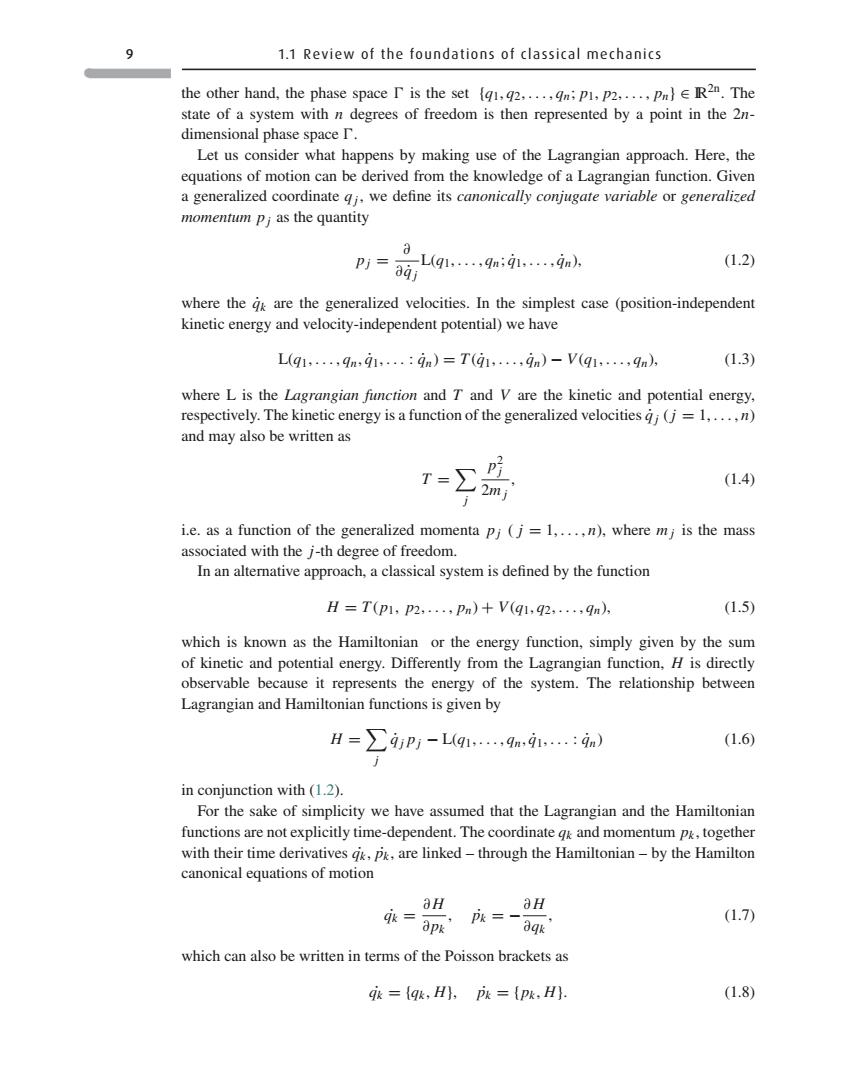正在加载图片...

9 1.1 Review of the foundations of classical mechanics the other hand,the phase space r is the setp.p2.....n)R2n.The state of a system with n degrees of freedom is then represented by a point in the 2n- dimensional phase space r. Let us consider what happens by making use of the Lagrangian approach.Here,the equations of motion can be derived from the knowledge of a Lagrangian function.Given a generalized coordinate gi,we define its canonically conjugate variable or generalized momentum p:as the quantity P时=3gg19a…9a以 (1.2) where theare the generalized velocities.In the simplest case(position-independent kinetic energy and velocity-independent potential)we have L(q1,,,91..:gn)=T(g1,,9n)-V(q1,9n) 13) where L is the Lag fmction andTand Vare the kineticand potential enery. respectively.The kinetic energy isafunction of the generalized velocities=1....) and may also be written as (1.4 i.e.as a function of the generalized momenta pj(j=1.....n).where mj is the mass associated with the j-th degree of freedom. In an altemative e approach,a classical system is defined by the function H=T(p1,p2,,pm)+V(q1,q2,9m (1.5) which is known as the Hamiltonian or the energy function,simply given by the sum of kinetic and potential energy.Differently fron he Lagrangian fun n.H is directly because it the nergy of the ystem.The relationship between Lagrangian and Hamiltonian functions is given by H=∑9jPj-L(q1,9n,g1…:4n) (1.6 in coniunction with (12). For the sake of simplicity we have assumed that the Lagrangian and the Hamiltoniar functions are not explicitly time-dependent.The coordinate qe and momentum p&,together with their time derivatives qs,p&,are linked-through the Hamiltonian-by the Hamilton canonical equations of motion =n=- (1.7) which can also be written in terms of the Poisson brackets as 张=qk,H,庆={Pk,H. (1.8)9 1.1 Review o f the founda tions o f classical mechanics the other hand, the phase space is the set {q1, q2, ... , qn; p1, p2, ... , pn} ∈ IR2n. The state of a system with n degrees of freedom is then represented by a point in the 2ndimensional phase space . Let us consider what happens by making use of the Lagrangian approach. Here, the equations of motion can be derived from the knowledge of a Lagrangian function. Given a generalized coordinate q j , we define its canonically conjugate variable or generalized momentum p j as the quantity p j = ∂ ∂q˙j L(q1, ... , qn; q˙1, ... , q˙n), (1.2) where the q˙k are the generalized velocities. In the simplest case (position-independent kinetic energy and velocity-independent potential) we have L(q1, ... , qn, q˙1, ... : q˙n) = T (q˙1, ... , q˙n) − V(q1, ... , qn), (1.3) where L is the Lagrangian function and T and V are the kinetic and potential energy, respectively. The kinetic energy is a function of the generalized velocities q˙j (j = 1, ... , n) and may also be written as T = j p2 j 2m j , (1.4) i.e. as a function of the generalized momenta p j ( j = 1, ... , n), where m j is the mass associated with the j-th degree of freedom. In an alternative approach, a classical system is defined by the function H = T (p1, p2, ... , pn) + V(q1, q2, ... , qn), (1.5) which is known as the Hamiltonian or the energy function, simply given by the sum of kinetic and potential energy. Differently from the Lagrangian function, H is directly observable because it represents the energy of the system. The relationship between Lagrangian and Hamiltonian functions is given by H = j q˙j p j − L(q1, ... , qn, q˙1, ... : q˙n) (1.6) in conjunction with (1.2). For the sake of simplicity we have assumed that the Lagrangian and the Hamiltonian functions are not explicitly time-dependent. The coordinate qk and momentum pk , together with their time derivatives q˙k , p˙k , are linked – through the Hamiltonian – by the Hamilton canonical equations of motion q˙k = ∂ H ∂pk , p˙k = −∂ H ∂qk , (1.7) which can also be written in terms of the Poisson brackets as q˙k = {qk , H}, p˙k = {pk , H}. (1.8)�